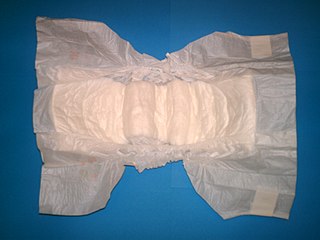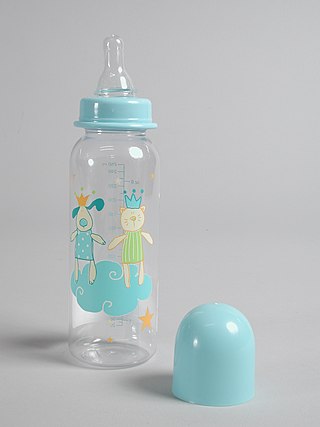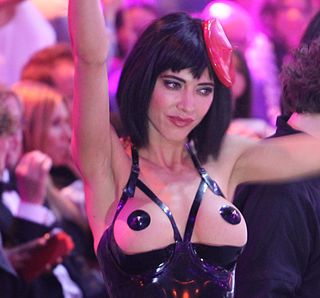
The breast is one of two prominences located on the upper ventral region of a primate's torso. Both females and males develop breasts from the same embryological tissues.

A diaper or a nappy is a type of underwear that allows the wearer to urinate or defecate without using a toilet, by absorbing or containing waste products to prevent soiling of outer clothing or the external environment. When diapers become wet or soiled, they require changing, generally by a second person such as a parent or caregiver. Failure to change a diaper on a sufficiently regular basis can result in skin problems around the area covered by the diaper.

The nipple is a raised region of tissue on the surface of the breast from which, in females, milk leaves the breast through the lactiferous ducts to breastfeed an infant. The milk can flow through the nipple passively or it can be ejected by smooth muscle contractions that occur along with the ductal system. Male mammals also have nipples but without the same level of function, and often surrounded by body hair.

A baby bottle, nursing bottle, or feeding bottle is a bottle with a teat attached to it, which creates the ability to drink via suckling. It is typically used by infants and young children, or if someone cannot drink from a cup, for feeding oneself or being fed. It can also be used to feed non-human mammals.

A menstrual cup is a menstrual hygiene device which is inserted into the vagina during menstruation. Its purpose is to collect menstrual fluid. Menstrual cups are made of elastomers. A properly-fitting menstrual cup seals against the vaginal walls, so tilting and inverting the body will not cause it to leak. It is impermeable and collects menstrual fluid, unlike tampons and menstrual pads, which absorb it.

A menstrual pad, or simply a pad, is an absorbent item worn in the underwear when menstruating, bleeding after giving birth, recovering from gynecologic surgery, experiencing a miscarriage or abortion, or in any other situation where it is necessary to absorb a flow of blood from the vagina. A menstrual pad is a type of menstrual hygiene product that is worn externally, unlike tampons and menstrual cups, which are worn inside the vagina. Pads are generally changed by being stripped off the pants and panties, taking out the old pad, sticking the new one on the inside of the panties and pulling them back on. Pads are recommended to be changed every 3–4 hours to avoid certain bacteria that can fester in blood; this time also may differ depending on the kind worn, flow, and the time it is worn.

A nursing bra is a specialized brassiere that provides additional support to women who are lactating and permits comfortable breastfeeding without the need to remove the bra. This is accomplished by specially designed bra cups that include flaps which can be opened with one hand to expose the nipple. The flap is usually held closed with a simple clasp or hook.

Pasties are patches that cover a person's nipples and areolae, typically self-adhesive or affixed with adhesive. They originated as part of burlesque shows, allowing dancers to perform fully topless without exposing the nipples in order to provide a commercial form of bare-breasted entertainment. Pasties are also, at times, used while sunbathing, worn by strippers and showgirls, or as a form of protest during women's rights events such as Go Topless Day. In some cases this is to avoid potential prosecution under indecency laws.

An inverted nipple is a condition where the nipple, instead of pointing outward, is retracted into the breast. In some cases, the nipple will be temporarily protruded if stimulated. Both women and men can have inverted nipples.

A nipple shield is a nipple-shaped sheath worn over the areola and nipple during breastfeeding. Modern nipple shields are made of soft, thin, flexible silicone and have holes at the end of the nipple section to allow the breast milk to pass through.

Cloth menstrual pads are cloth pads worn in the underwear to collect menstrual fluid. They are a type of reusable menstrual hygiene product, and are an alternative to sanitary napkins or to menstrual cups. Because they can be reused, they are generally less expensive than disposable pads over time, and reduce the amount of waste produced.

Ptosis or sagging of the female breast is a natural consequence of aging. The rate at which a woman's breasts drop and the degree of ptosis depends on many factors. The key factors influencing breast ptosis over a woman's lifetime are cigarette smoking, her number of pregnancies, higher body mass index, larger bra cup size, and significant weight change. Post-menopausal women or people with collagen deficiencies may experience increased ptosis due to a loss of skin elasticity. Many women and medical professionals mistakenly believe that breastfeeding increases sagging. It is also commonly believed that the breast itself offers insufficient support and that wearing a bra prevents sagging, which has not been found to be true.

Breast prostheses are breast forms intended to look like breasts. They are often used temporarily or permanently by women after mastectomy or lumpectomy procedures, but may also be used by for aesthetic purposes. There are a number of materials and designs; although, the most common construction is gel in a plastic film meant to feel similar to a person's skin. Prostheses may be purchased at a surgical supply store, pharmacy, custom lingerie shop, or even through private services that come to a person's home. There are many types of ready made breast prostheses including full or standard prostheses, partial prostheses such a shell prostheses, and stick on prostheses. Customized options are also available from specialty shops, which are moulded to fit an individual's chest by taking an impression of the breast(s). The areola and nipple may be replicated as part of the breast form or as separate nipple prosthesis. Both custom made and off-the shelf breast prostheses come in varieties that are designed to either be held in a pocket in a specially designed mastectomy bra or attached to the skin via adhesive or other methods and worn with a standard bra. There are many factors to consider when selecting breast prostheses such as different types and the care they require, insurance coverage, and psychosocial effects.

The history of bras is closely tied to the social status of women, the evolution of fashion, and shifting views of the female body over time.

Breast shells are hollow, lightweight plastic disks worn inside the brassiere to help correct flat or inverted nipples either in preparation for or during breastfeeding. Also known as milk cups, breast cups, breast shields, or Woolwich shields, they can also be used to ease sensitive nipples or collect milk when the baby has not finished the teat. Breast shells function by applying gentle but firm pressure to the region surrounding the nipple to stretch underlying adhesions and draw out the nipple. Nipple shields may be confused with breast shells, but shields are intended for use during the act of breastfeeding, whereas breast shells are worn in preparation for or after breastfeeding.
A bra, short for brassiere or brassière, is a form-fitting undergarment that is primarily used to support and cover a woman's breasts. A typical bra consists of a chest band that wraps around the torso, supporting two breast cups that are held in place by shoulder straps. A bra usually fastens in the back, using a hook and eye fastener, although bras are available in a large range of styles and sizes, including front-fastening and backless designs. Some bras are designed for specific functions, such as nursing bras to facilitate breastfeeding or sports bras to minimize discomfort during exercise.

An underwire bra is a brassiere that utilizes a thin, semi-circular strip of rigid material fitted inside the brassiere fabric to help lift, separate, shape, and support a woman's breasts. The wire may be made of metal, plastic, or resin. It is sewn into the bra fabric and under each cup, from the center gore to under the wearer's armpit. Many different brassiere designs incorporate an underwire, including shelf bras, demi bras, nursing bras, and bras built into other articles of clothing, such as tank tops, dresses and swimsuits.
Cracked nipple is a condition that can occur in breastfeeding women as a result of a number of possible causes. Developing a cracked nipple can result in soreness, dryness or irritation to, or bleeding of, one or both nipples during breastfeeding. The mother with a cracked nipple can have severe nipple pain when the baby is nursing. This severe pain is a disincentive for continued breastfeeding. The crack can appear as a cut across the tip of the nipple and may extend to its base. Cracked nipple can develop after the birth of the infant and is managed with pharmacological and nonpharmacological treatment.
A nipple bleb is a blister on the nipple that can be filled with serous or other fluid. It may be pink or light yellow. It is thin-walled and may appear as a small blister, more than 5 mm in diameter. It can also be referred to as a bulla. Some clinicians may also include milk blisters as a type of bleb. In addition, a blocked Montgomery gland may also be called a nipple bleb though its cause is different than a milk or serous-filled bleb on the nipple. In some cases the bleb may be associated with an adjacent blocked sebaceous cyst.















